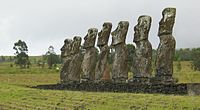Moai

Moai are stone statues on Easter Island. Each moai is made out of one large stone but some have an extra stone on top of the head. Most were made from the volcanic rock in the Rano Raraku area of the island. Moai are sometimes called "heads" but they do have shoulders, arms, and a body but these are usually too small for the head, also some of the best known ones had been partly buried over the years and only the heads were showing. Most moai are between 2.5 and 10 metres high and, usually, weigh 14 tonnes. There are about 1000 moai placed mainly around the coast of the island plus nearly 400 more which were left not yet finished at Rano Raraku.

When, why, and how they were made is still a mystery today. It is believed that they were made almost 1000 years ago by Polynesians, who lived there at the time and were made to honour their ancestors (older family members long dead) and bring good luck. Making the statues would have needed a lot of time and effort. To move them, they may have used wooden sledges or rollers or even "walked" them by rocking the moai along. The youngest moai found was built around 1350. It is believed that, around that time, there began a time of cold weather, little food, and war between the peoples. By the 19th century, all the moai had been pushed over. Today, some have been restored.


References
[change | change source]- Grant McCall (1995). "Rapanui (Easter Island) Archived 2000-08-16 at the Wayback Machine." Pacific Islands Year Book 17th Edition. Fiji Times. Retrieved August 8, 2005.
- Thor Heyerdahl, Arne Skjølsvold, and Pavel Pavel The "Walking" Moai of Easter Island. Retrieved August 8, 2005.
- Kathy Pelta (2001). Rediscovering Easter Island. North Minneapolis, USA:Lerner Publications. ISBN 0822548909.
- Rupert Matthews (1988). Ancient Mysteries. East Sussex, England:Wayland. ISBN 0531182460.
Other websites
[change | change source]- Unofficial Easter Island Homepage Archived 2007-08-10 at the Wayback Machine
- PBS NOVA: Secrets of Easter Island
- PBS NOVA: Secrets of Lost Empires: Easter Island
- How to make Walking Moai: A hypothesis about transportation method on Easter island